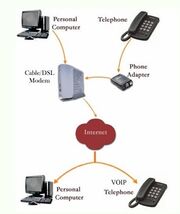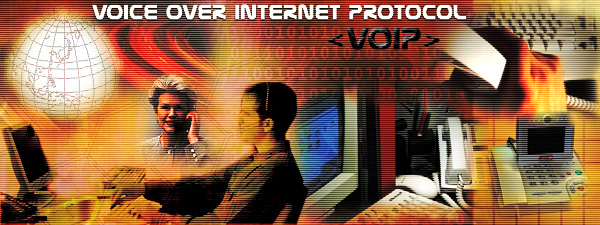Definitions[]
Voice over IP (or Voice over Internet Protocol or VoIP) is a
| “ | service, which allows a caller using a broadband Internet connection to place calls to and receive calls from other callers using either VoIP or traditional telephone service.[1] | ” |
| “ | a technology that allows you to make voice calls using a broadband Internet connection instead of a regular (or analog) phone line. Some VoIP services may only allow you to call other people using the same service, but others may allow you to call anyone who has a telephone number — including local, long distance, mobile, and international numbers. Also, while some VoIP services only work over your computer or a special VoIP phone, other services allow you to use a traditional phone connected to a VoIP adapter.[2] | ” |
Overview[]
Basic VoIP access usually allows you to call others who are also receiving calls over the Internet. Interconnected VoIP services also allow you to make and receive calls to and from traditional landline numbers, usually for a service fee. Some VoIP services require a computer or a dedicated VoIP phone, while others allow you to use your landline phone to place VoIP calls through a special adapter.
VoIP is becoming an attractive communications option for consumers. Given the trend towards lower fees for basic broadband service and the brisk adoption of even faster Internet offerings, VoIP usage should only gain popularity with time. However, as VoIP usage increases, so will the potential threats to the typical user. While VoIP vulnerabilities are typically similar to the ones users face on the Internet, new threats, scams, and attacks unique to IP telephony are now emerging.
The VoIP solution provides a cheaper and clearer alternative to traditional Public Switched Telephone Network (PSTN) telephone lines. Although its implementation is widespread, the technology is still developing. It is growing rapidly throughout North America and Europe, but it sometimes can be difficult to integrate with existing systems. Nevertheless, VoIP will capture a significant portion of the telephony market, given the fiscal savings and flexibility that it can provide.
VoIP systems take a wide variety of forms, including traditional telephone handsets, conferencing units, and mobile units. In addition to end-user equipment, VoIP systems include a variety of other components, including call processors/call managers, gateways, routers, firewalls, and protocols. Most of these components have counterparts used in data networks, but the performance demands of VOIP mean that ordinary network software and hardware must be supplemented with special VoIP components.
Not only does VoIP require higher performance than most data systems, critical services, such as Emergency 911 must be accommodated. One of the main sources of confusion for those new to VoIP is the (natural) assumption that because digitized voice travels in packets just like other data, existing network architectures and tools can be used without change. However, VoIP adds a number of complications to existing network technology, and these problems are magnified by security considerations.
How VoIP works[]
VoIP converts the voice signal from a telephone into a digital signal that can travel over the Internet. If the call is made from a regular telephone number, the signal is then converted back at the other end. Depending on the type of VoIP service, a VoIP call can be made from a computer, a special VoIP phone, or a traditional phone with or without an adapter. In addition, new wireless "hot spots" in public locations such as airports, parks, and cafes allow a user to connect to the Internet, and may enable the user to use VoIP service wirelessly.

Example of VoIP configuration
VOIP equipment[]
VOIP systems take a wide variety of forms. Just about any computer is capable of providing VOIP; Microsoft’s NetMeeting, which comes with any Windows platform, provides some VOIP services, as does the Apple Macintosh iChat, and Linux platforms have a number of VOIP applications to choose from. In general, though, the term Voice over IP is associated with equipment that provides the ability to dial telephone numbers and communicate with parties on the other end of a connection who have either another VOIP system or a traditional analog telephone.
VoIP configurations[]
Dedicated routers[]
These devices allow you to use your traditional telephone to place VoIP calls. They are connected to cable/DSL modems (or any high-speed Internet source) and allow you to attach an ordinary telephone. Once configured, and with an appropriate VoIP provider and service plan, these devices require no special software or interaction with a computer. In fact, you only need to pick up your phone and dial a number at the dial tone. You also may bring your adapter with you when you travel and make calls wherever broadband Internet access is available.
Adapters (USB)[]
These devices also allow you to use a traditional phone to place VoIP calls. They usually come in the form of USB adapters that are slightly larger than the typical thumb drive. They feature a standard modular phone jack to which you can attach an ordinary phone line. Once connected, your phone behaves as if it were connected to standard phone service. Behind the scenes, however, the included software is actually setting up a VoIP call.
Software-controlled VoIP applications: “softphones”[]
There are many software applications (“softphones”) that allow you to place VoIP phone calls directly from an ordinary computer with a headset, microphone, and sound card. Internet telephony service providers usually give away their softphones but require that you use their service. Together, these applications and services enable users to talk to other people using the same service at no cost, and to the rest of the world for a fee. Software-based VoIP applications are quite attractive to consumers because they often already have most of the components necessary to get started at little to no cost.
Dedicated VoIP phones[]
A VoIP phone looks like an ordinary corded or cordless telephone, but it connects directly to a computer network rather than a traditional phone line. A dedicated VoIP phone may consist of a phone and base station that connects to the Internet or it may also operate on a local wireless network. Like the VoIP adapters mentioned above, dedicated VoIP phones also require a provider and service plan.
Quality of service and security[]
Quality of Service (QoS) is fundamental to the operation of a VoIP network that meets users' quality expectations. However, the implementation of various security measures can cause a marked deterioration in QoS unless VoIP-specific equipment and architectures are used. These complications range from firewalls delaying or blocking call setups to encryption-produced latency and delay variation (jitter).
Because of the time-critical nature of VoIP and its low tolerance for disruption and packet loss, many security measures implemented in traditional data networks are simply not applicable to VoIP in their current form. Firewalls, intrusion detection systems, and other components must be specialized for VoIP.
Confidentiality[]
Many critics of VoIP question its confidentiality. The concern is that VoIP data sometimes travels unencrypted over the Internet. Therefore, it is technically possible for someone to collect VoIP data and attempt to reconstruct a conversation. Although it is extremely difficult to achieve, some software programs are designed to piece together bits and pieces of VoIP data in an effort to reconstruct conversations. While such activity is currently rare, this possibility as it may increase as VoIP becomes more widespread.
References[]
- ↑ Nuvio Corp. v. Federal Comm. Comm’n, 473 F.3d 302, 303 (D.C. Cir. 2006) (full-text).
- ↑ Federal Communications Commission, IP-Enabled Services (full-text).
